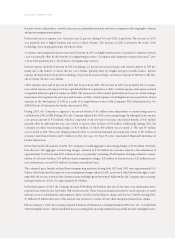American Express 2003 Annual Report Download - page 33
Download and view the complete annual report
Please find page 33 of the 2003 American Express annual report below. You can navigate through the pages in the report by either clicking on the pages listed below, or by using the keyword search tool below to find specific information within the annual report.
Net securitization income at TRS rose 10 percent in 2003 as a result of a higher average balance of cardmember lending
securitizations. Net securitization income at TRS rose 24 percent in 2002 primarily driven by a higher average balance of
cardmember lending securitizations as well as higher portfolio yields.
Other revenues increased 18 percent in 2003 primarily due to higher card and merchant-related revenues at TRS and higher
financial planning and advice services fees at AEFA. Other revenues declined 5 percent during 2002.
Expenses
Consolidated expenses increased 8 percent in 2003 reflecting increases of 7 percent at TRS, 12 percent at AEFA and 4 per-
cent at AEB. As discussed below, the increase in 2003 was driven by increased marketing, promotion, rewards and card-
member services expenses, higher human resources expense, greater professional services expense and higher other
expenses partially offset by lower funding costs and provisions for losses. Consolidated expenses decreased 4 percent in
2002 primarily due to a decline in human resources expense, lower interest expense, reduced provisions for losses and the
benefits of reengineering activities and expense control initiatives.
Human resources expense increased 11 percent in 2003 due to increased costs related to merit increases, employee benefit
expenses and management incentive costs, including higher stock-based compensation costs from both stock options and
increased levels of restricted stock awards as well as the impacts of fourth quarter acquisitions. The higher stock-based com-
pensation expense from stock options reflects the Company’s decision to expense stock options beginning in 2003. Higher
expense related to restricted stock awards reflects the Company’s decision to modify compensation practices and use
restricted stock awards in place of stock options for middle management. These increases were partially offset by lower
staffing levels, excluding the impact of the Rosenbluth and Threadneedle acquisitions. Human resources expense declined
9 percent in 2002 primarily as a result of lower staffing levels and the benefit of reengineering activities, including the impact
of outsourcing agreements.
Total provisions for losses and benefits declined 3 percent in 2003, primarily driven by an 11 percent decline in both the
charge card and lending provisions at TRS. The decrease in the provisions at TRS was primarily due to strong credit qual-
ity as reflected in improved past due and write-off rates, despite strengthening of past due reserve coverage ratios. These
decreases were partially offset by a 7 percent net increase in annuity and investment certificate provisions at AEFA. Annu-
ity provisions increased primarily due to higher inforce levels, the effect of appreciation in the S&P 500 on equity indexed
annuities in 2003 versus depreciation in 2002, partially offset by the benefit of lower interest crediting rates on fixed annu-
ity contract values and decreased costs related to guaranteed minimum death benefits. Investment certificate provisions
increased due to the effect on the stock market certificate product of appreciation in the S&P 500 in 2003 versus depreci-
ation in 2002 and higher average investment certificate levels, partially offset by the benefit of lower interest crediting rates.
Total provisions for losses and benefits declined 3 percent in 2002, resulting from a 20 percent reduction in the charge card
provision at TRS due to strong credit quality and an 8 percent reduction in provision for losses and benefits on annuities
and investment certificates, primarily due to lower interest crediting rates on the investment certificate product. These
decreases were partially offset by a 14 percent increase in life insurance, international banking and other provisions and a
4 percent increase in cardmember lending provisions at TRS.
Marketing, promotion, rewards and cardmember services expenses increased 25 percent in 2003 including a 26 percent
increase at TRS. Higher expenses were a result of the continuation of brand and product advertising, an increase in selected
card acquisition activities and higher cardmember rewards and services expenses reflecting higher volumes and greater
rewards program participation and penetration. While the amount of these expenses is expected to continue to rise, the
growth rate for these costs is expected to be lower in 2004 as loyalty program utilization begins to stabilize and the Com-
pany further leverages expenditures made during 2003. Management believes, based on historical experience, that card-
members enrolled in rewards and co-brand programs yield higher spend, better retention, stronger credit performance and
greater profit for the Company. Marketing, promotion, rewards and cardmember services expenses increased 15 percent in
2002 primarily due to a 14 percent increase at TRS relating to the launch of a new brand advertising campaign and the intro-
(p.31_axp_ financial review)
























